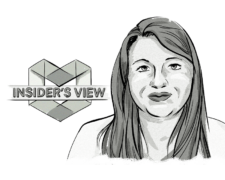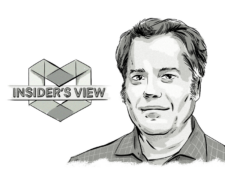“One of the main reasons why personalization works is because humans like to hear things that we recognize and that feel familiar, such as our location, time or weather.”
When radio moved from analog to digital, it opened a whole new world of opportunities.
For the latest edition of Insider’s View: AdTech & MarTech Q&A, we caught up with Steve Dunlop, Founder and CEO of A Million Ads, who saw one such opportunity and decided to run with it.
You can connect with Steve on LinkedIn.
Tell us a bit about your background and how you ended up founding A Million Ads
My background is in engineering. At university, I studied all different types of engineering, from structural and civil to mechanical and electrical.
My first real job out of university was working as a strategy consultant for a small, boutique telecoms-and-media company called Spectrum.
I’ve always been fascinated with radio and audio, so after about six years at Spectrum, I moved to Manchester and worked as a producer for a rock-music radio station called Xfm.
It was at Xfm where I learned the art of storytelling through audio – using voice, music and sound effects, rather than visuals, to tell a story in a short space of time.
Then in 2013, I started working for the UK’s largest radio operator, Global Radio, as Head of Strategy and Development.
Part of my job was to migrate the old-school analog broadcast setup to the new world of digital media to more effectively compete with companies like Spotify and Pandora.
One of the main projects I worked on at Global was launching the digital audio exchange (DAX), which allows advertisers to buy digital-audio inventory coming from devices connected to the Internet, such as smartphones.
So if you were listening to the radio in your car, you’d hear a broadcast ad, whereas if you were listening to the radio on your iPhone, you’d hear a digital ad.
The move to digital-audio ads provided advertisers the same opportunities as digital ads in other media, such as targeting, segmentation and audience-buying.
However, I noticed that the 30-second broadcast ads that people heard in their cars were exactly the same as the digital ads people would hear on their phones, meaning advertisers weren’t taking advantage of this new opportunity to personalize the ads, despite having the possibility to do so.
I started looking around to see if anyone had already come up with a solution to this, but it turned out that nobody had.
So in the summer of 2015, I decided to quit my job and set out to solve this very problem.
That’s how A Million Ads was born.
What is A Million Ads and what does the company do exactly?
A Million Ads is a dynamic creative and personalization platform for digital-audio ads.
The solution is actually quite simple. A Million Ads takes some information known about the user and delivers an ad that sounds like it was made especially for them.
For example, based on the person’s time zone, we can tell whether its the morning, afternoon or evening, and what day of the week it is.
We use location data to determine which city you’re in, which also gives us information about the weather at the time. We also know which device you are using and how many times you’ve heard a particular ad, so we know which stage of the campaign you are in.
All of this makes it possible to create a unique ad that feels like its speaking to each individual user.
As most people listen to audio services via headphones (Spotify says it’s roughly 70%), it creates this very intimate connection whereby we’re able to deliver a message straight into someone’s brain almost.
We feel that this was a huge and untapped opportunity for which we have the solution, so we built a tool that allows advertisers to design and create these ads.
How are you able to create so many of these highly personalized and dynamic ads when the incoming data changes all the time?
The way it works is that you record small parts of an ad and then match them together to create a complete ad.
So, for example, if it’s the morning and you’re in Manchester, the first part of the ad would be broken up in the following way:
Part 1: “How’s your morning going…”
Part 2: …in Manchester?”
We record the different versions of these parts and then our system mixes them together, along with music and sound effects, to create a great-sounding, complete ad that matches the environment the user is in.
Here’s an example of what the recording session looks like:
100 thousand ads in one hour! from A Million Ads on Vimeo.
By recording all these different pieces, it’s as easy for us to create a million versions of one ad as it is for us to create one.
It sounds like advertisers can get quite specific with the messaging and produce a lot of variations. What’s the biggest number of versions of one ad your company has ever created?
The biggest number of variations for a single ad that we’ve ever created was around 8.3 million.
This particular client had 400 store locations and 20 different products that they wanted to advertise. When you multiply that with other variables, such as the days of the week, weather or temperature, and the time of day, you can see how quickly it is to get this large number of variations.
If an ad is made up of many different pieces, how are you able to deliver these dynamic and personalized creatives to the user as a complete creative?
So the actual delivery is done through the Video Ad-Serving Template (VAST).
Once upon a time, ad servers and demand-side platforms (DSPs) would send a static audio file in the ad/bid response, but now, many audio-enabled ad servers and DSPs allow advertisers to insert VAST tags, so when a DSP wins the impression, we are called to retrieve the creative. We look at the available data in the bid request and decide which ad to send back.
From there, we respond back with all the usual tracking tags and also an MP3 or OGG file which will be rendered into the audio player.
All that happens at ad-tech speed, usually around 20–30ms.
We know that dynamic ads in the display world perform better, but is it the same with audio ads?
We’ve found that the more personalized the ad, the better it performs, and we’ve got plenty of data from our clients’ campaigns that prove this.
One such example is a campaign from British Gas. In order to really test the impact of the personalized and dynamic ads, the energy giant added conversion pixels to its website to see which ad delivered the most conversions – the plain, static version or our personalized, dynamic one.
It turned out that the conversion rate of the personalized and dynamic ad was 2.4x higher than the static one.
One of the main reasons why we feel personalized and dynamic audio creatives work is because humans like to hear things that we recognize, such as our location, time of day or weather.
Which DSPs are you connected to?
We connect to the audio-specific platforms like Triton Digital and Adswizz, as well as the major DSPs that are now enabling audio in their products, such as Adobe.
In addition to that, we work with many of the music-streaming, internet-radio, and podcast publishers around the world.
Who do you work with to create these ads?
Although our clients are advertisers, agencies, and brands, we typically work with producers, creative agencies and audio specialists who use our platform to produce the ad – i.e. create the scripts and add in the various audio elements (voice overs, background music, etc.).
We also have an in-house creative team, so we sometimes create the ads ourselves.
What are your goals as a company over the next 12 months?
One of our main goals is to continue educating brand advertisers and agencies about the opportunities of digital audio and, more specifically, how dynamic creative and personalization can deliver higher conversion rates, more sales, etc.
We are also updating our studio tool to add AI-assisted creativity features as well as releasing a podcast-specific version of our tool, just for podcast advertisers and producers.
Finally, we will be releasing a video-enabled version of our tool to allow advertisers to truly personalize their video advertising.







